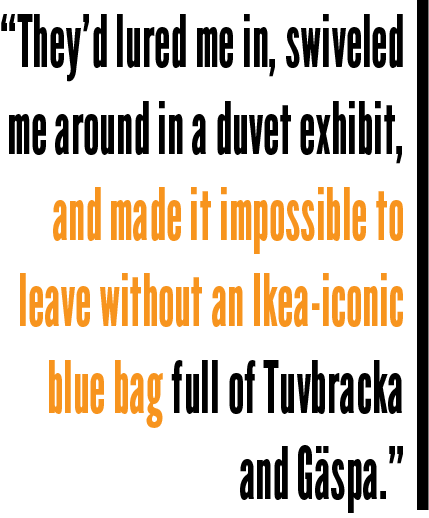Several years ago, I ventured into an Ikea store in Emeryville, California. I’d recently moved to the Bay Area for college, and my off-campus apartment needed a few odds and ends to make it feel more like home and less like a damp cell. As I perused the bright aisles brimming with perfect furniture displays and textiles, I soon found myself between a Lugnvik and a hard place.

I was completely lost; over an hour had passed, and my cart was somehow full. I gazed at the rows and rows of printed shower curtains as I came out of my consumer-coma, wandering from one contemporary mock-room to another, wherein every ottoman, bookshelf, and throw pillow was thoughtfully arranged and color coordinated. It felt as if I was stepping right into the catalog showcase.
They’d lured me in, swiveled me around a duvet exhibit, and made it impossible to leave without an Ikea-iconic blue bag full of Tuvbracka and Gäspa.
Ikea is a worldwide success. The Swedish lifestyles giant has over 300 stores in 41 countries, and according to Ikea, over 500 million people visit their stores each year. The largest Ikea is in Stockholm, Sweden, and is a 552,000 square-foot labyrinth of home furnishings that aim to make your life better, one Lack side table at a time. Ikea even rolled out a new line of flat-pack houses, inexpensive homes that are shipped and assembled for you.
The one thing Ikea serves up hotter than their authentic Swedish Meatballs (150 million of them annually) is their direct mail campaign. Their star mailer? A 300-page book, featuring their beautifully showcased modern home products.
The novelty of the Ikea catalog is perfectly represented by a parody advertisement, which introduces the 2015 IKEA catalog as a technology that is “not a digital book or an e-book,” but rather a “book-book.” The catalog campaign advertisement, “Experience the Power of a BookBookTM” is so seamlessly executed that it received over 9 million views in its first week online.

These days, print catalogs are unique by nature — a sleek, tactile object in a distracting digital world — and Ikea’s marketing department banks on that difference. Ikea is estimated to have made around €32 billion ($36.35 billion) in 2015. Since it is estimated that businesses in general earn 17 percent in sales from catalogs, Ikea could be making around €5.44 billion ($6.18 billion) on their catalog campaign alone.
What the Ikea Catalog Teaches Entrepreneurs About Direct Mail
On my first trip to Ikea, I could imagine myself living in one of these display rooms, curled up on a soft sectional, or sipping a cup of tea at an Övraryd bamboo table. Ikea allows you to literally step into the possibilities, and the catalog is an extension of the company’s understanding of lifestyle. If you’re implementing direct mail into your marketing, you can learn a thing or two from how Ikea executes their catalog campaign.
Keep It Stylish
Ikea uses a solution-focused design, not only in their furniture (they do anthropological studies at people’s homes to find out what it is people truly need), but in their brand design as well. Keep in mind that you are offering a solution to your audience, and that solution should be apparent from simply seeing the ease of the print in their hands. Busy, cluttered, or overly complicated text will be an immediate turn-off. Design with care or seek the help of a professional.
Furthermore, arm your readers with solutions by giving them accessible information that adds value to their lives. Like a beautifully designed family room display, give your audience an idea of what life with your product could look like. Don’t just show them, inspire them!

Assembly Required
Direct mail should be used as one important piece of your overall marketing campaign. For the catalog and other direct mail campaigns, Ikea leveraged social media and email marketing to generate leads and earn sign-ups for their print catalog. Use the information you can obtain from your online marketing campaigns to create a list for your print newsletter or direct mail campaign.
Ikea implemented a very diversified marketing strategy using a combination of direct mail, social media, and email marketing. All of their strategies worked together to form a bigger picture. In addition, a new interactive feature makes it possible to scan select items in the catalog using a smartphone camera, and doing so unlocks extra content, like film, a photo gallery, and additional information on the product.
Be Expandable
In order for your direct mail campaign to be a success, you need to constantly expand your reach far and wide and find leads who will appreciate what you’re offering. This may mean you have to adapt to new markets and different ways of doing things, but a larger audience means you’ll have more customers, and your brand will be on the tables of more homes. Touch base with new and old leads, and make it easy for interested parties to sign up for your mailer on your website or a table in your brick-and-mortar shop.
Launched in 1951, just a few years after Ingvar Kamprad founded the furniture company, Ikea now prints over 200 million copies of their catalogs per year, and it can be found in 27 different languages distributed across 28 countries. Now that’s what I call “reach.”
Although Ikea is a worldwide behemoth, and any small-business owner can learn a thing or two from their highly successful direct mail campaign.
While you may not have the product base to warrant the production of a catalog, you can still leverage the power of this specialized mailer with a newsletter that showcases all your company has to offer.






